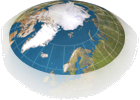 |
Litteratur |
| |
AMAP (1997) Arctic Pollution Issues:
A State of the Arctic Environment Report. Arctic Monitoring and
Assessment Programme, Oslo. 188pp. Available on the AMAP web site
(http://www.grida.no/amap)
A beautifully written and well illustrated summary of the Arctic
system, its physical pathways, ecology and people (first 70 pages).
Followed by understanding of how different pollutants enter the
system, are transferred within it and the impacts on the system
and on Humans. The main source for many of the figures. |
| |
Chapin et al. (1992) Arctic Ecosystems
in a Changing Climate: An Ecophysiological Perspective. Academic
Press. 467pp.
For the technically minded. This is still one of the best series
of papers on how Arctic organisms will respond to climate change.
Good general introductory chapters on the Arctic System; followed
by carbon, water and nutrient dynamics; then interactions; and summary.
A connected series of papers which build up to thoughtful synthesis. |
| |
Chapin, F.S & Korner, C. (Eds.)
(1995) Arctic and Alpine Biodiversity: Patterns, Causes and Ecosystem
Consequences. Ecological Studies Vo.113. Springer-Verlag, Berlin,
New York, London.
A comprehensive view of the diversity of organisms, their distribution,
adaptations, dynamics and interactions. Useful for the specialist
but also provides an insight into the underestimated diversity of
species and also provides illuminating comparisons with Alpine environments
- another cryosphere. |
| |
Chernov, Yu.I. (1980) Zhizn' tundry.
Izdatel'stvo. Mysl. English translation by D. Love (1985). The living
tundra. Cambridge University Press. 213pp.
A thorough and balanced insight into the biology of northern lands
with detailed ecology of the diversity of species, how they interact
and how they are adapted to their environments. Includes excellent
descriptions of the physical environment and the soil dynamics.
Written by one of the Arctic experts in a highly readable form.
(Available in paperback). |
| |
Fogg, G.E. (1998). The Biology
of Polar Habitats. Oxford University Press, Oxford, 263pp.
An authoritative scientific comparison of Arctic and Antarctic environments
and ecology. Geoffrey Fogg covers all the major habitats from personal
experience and briefly reviews the influence of mankind on polar
regions. Not an easy read but worth the effort. |
| |
Kurlansky, M (1997) Cod. A Biography
of the Fish that Changed the World. Penguin Books. 294pp.
Not strictly Arctic but a fascinating account of how different nations
exploited cod; how it changed their economies, caused wars, adapted
cultures. An unlimited supply which underpinned the seas ecology
as well as the nations - and eventually crashed. The chapters move
from place to place and time to time building a fascinating mosaic.
A superb lesson in Unsustainable Use. |
| |
Lovelock, J (2000) Gaia. A new
Look at Life on Earth. Oxford University Press, Oxford. 148pp.
A creative, stimulating and credible vision of the Earth as a self-regulating
system which has evolved over eons. A highly readable book by an
eminent scientist, reprinted with a new preface (the first edition
was published in 1979). |
| |
Nuttall, Mark & Terry Callaghan
(eds.) (2000). The Arctic: Environment, People, Policy. Harwood
Academic Publishers, Amsterdam, 647pp.
A comprehensive coverage of the physical environment; land, freshwater
and marine biology including human health; social and political
dimensions; human impacts on the Arctic environment and the policy
responses. The 22 chapters are written by 35 authorities from 8
different countries and give a balanced, in-depth coverage. An expensive
but valuable source of information. |
|
